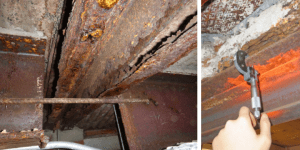
Recent heavy rains and flooding in New York City have underscored the problem that impacts most sidewalk vaults: water infiltration causing corrosion of their steel elements. If left unresolved, the structural degradation can lead to a sidewalk collapse. But in many cases, this damage is superficial and steel can be salvaged instead of scrapped.
When corrosion is observed through a vault inspection, it may appear that the steel requires wholesale removal and replacement. But in our extensive experience restoring sidewalk vaults, we’ve developed various methods of rehabilitation that don’t require complete, costly reconstruction.
When probes are deployed to assess the condition of corroded steel in sidewalk vaults, it’s important to keep some chemistry in mind: steel expands up to eight times when it rusts, so an inch-thick layer of rust represents a loss in cross section of only about an eighth of an inch of uncorroded steel. So, when cleaned of corrosion and measured, if a steel beam still has sufficient thickness to bear the load required, it can remain in place and continue to serve its purpose.
In other cases, only specific surfaces of a steel beam have corroded beyond the point of no return. For example, if the beam’s bottom flange is corroded to the extent that it requires reinforcement, the beam’s structural capacity can be restored by introducing a plate to reinforce the flange. If the desired strength requires greater reinforcement, an inverted T can be welded to the bottom flange to increase the beam’s capacity. An existing beam with compromised structural integrity can also be reinforced through the introduction of new support at midspan.
Another scenario we’ve encountered is a vault with a defective structural slab but sound supporting steel structure. In that case, our design called for a reinforced steel deck, supported by brackets attached to the beams, to be installed at the underside of the defective slab. Holes are made in the existing slab through which self-consolidating concrete is poured to form a new slab beneath the defective one.
In every case of sidewalk vault showing signs of rusted steel, a crucial component of restoration is to stop water infiltration to keep corrosion from recurring. Steel elements must be coated, waterproofing membranes above the structural slab must be repaired or replaced, and cracks and open joints in sidewalk slabs must be sealed to keep water out of vault spaces. You might call it a proactive campaign of underground resistance.
14 Wall Street, 25th Floor, New York, NY 10005
(212) 505 1133
info@superstructures.com
Subscribe to SuperScript, our email newsletter.